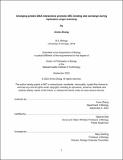| dc.contributor.advisor | Bell, Stephen | |
| dc.contributor.author | Zhang, Annie | |
| dc.date.accessioned | 2023-11-27T15:22:12Z | |
| dc.date.available | 2023-11-27T15:22:12Z | |
| dc.date.issued | 2023-09 | |
| dc.date.submitted | 2023-11-15T18:01:16.540Z | |
| dc.identifier.uri | https://hdl.handle.net/1721.1/153031 | |
| dc.description.abstract | DNA replication is a fundamental process that ensures the faithful duplication of genetic material in all living organisms. In eukaryotic cells, DNA replication proceeds bidirectionally from origins of replication. At the heart of this process is the eukaryotic replicative helicase, Mcm2-7, which leads the replication process by unwinding the DNA strands at the front of the replication machinery. To prepare for bidirectional replication, the hexameric Mcm2-7 helicases must be loaded onto origins of replication as head-to-head double hexamers in a process named helicase loading. Recent studies revealed that one molecule of the helicase loader, the origin- recognition complex (ORC), sequentially loads two Mcm2-7 hexamers in the precise orientation required for bidirectional replication. ORC initiates this process by binding to a high-affinity DNA binding site to load the first Mcm2-7 hexamer. Subsequently, ORC transitions to bind a secondary, inverted binding site to load the second Mcm2-7 in the opposite orientation. The precise molecular mechanism of this binding site exchange remains poorly understood.
In my thesis, I used single-molecule Förster resonance energy transfer (sm-FRET) to investigate the mechanism of ORC site-switching during helicase loading. I monitored the changing interactions between DNA and ORC or Mcm2-7 and characterized the kinetics of DNA conformational changes. I also identified a series of molecular events that lead to a stepwise decrease in ORC stability on DNA, which facilitates ORC dissociation from its initial DNA binding site during site-switching. In addition, I characterized the first helicase-loading intermediate that slides on DNA, providing an explanation for how ORC reaches the secondary binding sites located at diverse locations relative to the first site. These findings highlight the importance of dynamic protein-DNA interactions in loading oppositely-oriented Mcm2-7 helicases for bidirectional DNA replication. | |
| dc.publisher | Massachusetts Institute of Technology | |
| dc.rights | In Copyright - Educational Use Permitted | |
| dc.rights | Copyright retained by author(s) | |
| dc.rights.uri | https://rightsstatements.org/page/InC-EDU/1.0/ | |
| dc.title | Changing protein-DNA interactions promote ORC binding site exchange during replication origin licensing | |
| dc.type | Thesis | |
| dc.description.degree | Ph.D. | |
| dc.contributor.department | Massachusetts Institute of Technology. Department of Biology | |
| dc.identifier.orcid | 0000-0003-3939-2585 | |
| mit.thesis.degree | Doctoral | |
| thesis.degree.name | Doctor of Philosophy | |
